- Home
- Robert J. Mrazek
Valhalla
Valhalla Read online
Praise for Robert J. Mrazek and His Novels
“Great writing . . . great history.”
—Nelson DeMille
“A priceless novel . . . a must-read book . . . a great tale.”
—The Washington Times
“A novel of suspense and intrigue woven into the fabric of . . . history.”
—The Atlanta Journal-Constitution
“A superb piece of literature, rich in texture and of surpassing literary merit.”
—Robert K. Krick, author of Stonewall Jackson at Cedar Mountain and Lee’s Colonels
“A rattling good adventure story.”
—James M. McPherson, Pulitzer Prize–winning author of War on the Waters
“A simple tale almost magically rendered.”
—The Denver Post
“A rare find: a book that successfully combines mystery, historical drama, and impressive wartime verisimilitude . . . stark, graphic, bloody, and exciting.”
—Publishers Weekly
“A fast-paced thriller laced with violence and filled with unexpected twists that keep the reader guessing to the last page.”
—Rennie Airth, author of River of Darkness
“A first-rate World War II adventure.”
—Susan Isaacs, New York Times bestselling author of Goldberg Variations
“Tautly gripping, with vividly malevolent characters and some excellent historical color.”
—Kirkus Reviews
“[An] exciting thriller.”
—Historical Novel Society
“Full of dark twists and turns, this brooding drama underscores the brutal nature of both the physical and the psychological casualties associated with war.”
—Booklist
Praise for Robert J. Mrazek’s Nonfiction
To Kingdom Come
“Riveting.”
—Library Journal
“A great book with ‘hold on to your seat’ suspense.”
—Donald Miller, author of Masters of the Air: America’s Bombers Who Fought the Air War Against Nazi Germany
“Rendered . . . in vivid clarity.”
—Hugh Ambrose, New York Times bestselling author of The Pacific
“[A] work of cinematic sweep and pace.”
—Richard Frank, author of Downfall and Guadalcanal
“Superb historical research and powerful narrative writing.”
—Tami Biddle, professor, U.S. Army War College, and author of Rhetoric and Reality in Air Warfare
A Dawn Like Thunder
“Strap yourself in as Robert J. Mrazek takes you on a heroic flight into history.”
—James Bradley, author of Flyboys and Flags of Our Fathers
“A spectacular achievement.”
—Hon. Charles Wilson of Charlie Wilson’s War
“A remarkably vivid tale . . . [an] epic story.”
—Rick Atkinson, author of The Guns at Last Light and The Day of Battle
“Destined to become a classic.”
—Alex Kershaw, author of The Liberator and The Longest Winter
“Fast-paced. . . . [Mrazek] melds a good story with solid and skeptical research.”
—The Washington Post
“A must read . . . gripping.”
—Curled Up with a Good Book
“Robert J. Mrazek has, with a raw, unsparing telling, given grace and life to so many who died so young . . . so gallantly.”
—Frank Deford, author of Over Time
“Compelling.”
—The Columbus Dispatch
SIGNET
Published by the Penguin Group
Penguin Group (USA) LLC, 375 Hudson Street,
New York, New York 10014
USA | Canada | UK | Ireland | Australia | New Zealand | India | South Africa | China
penguin.com
A Penguin Random House Company
First published by Signet, an imprint of New American Library,
a division of Penguin Group (USA) LLC
Copyright © Robert Mrazek, 2014
Penguin supports copyright. Copyright fuels creativity, encourages diverse voices, promotes free speech, and creates a vibrant culture. Thank you for buying an authorized edition of this book and for complying with copyright laws by not reproducing, scanning, or distributing any part of it in any form without permission. You are supporting writers and allowing Penguin to continue to publish books for every reader.
REGISTERED TRADEMARK—MARCA REGISTRADA
ISBN 978-0-698-14867-3
PUBLISHER’S NOTE
This is a work of fiction. Names, characters, places, and incidents either are the product of the author’s imagination or are used fictitiously, and any resemblance to actual persons, living or dead, business establishments, events, or locales is entirely coincidental.
Version_1
Contents
Praise
Title page
Copyright page
Dedication
Epigraph
PROEM
THE RUNES OF THE GODS
CHAPTER ONE
CHAPTER TWO
CHAPTER THREE
CHAPTER FOUR
CHAPTER FIVE
CHAPTER SIX
CHAPTER SEVEN
CHAPTER EIGHT
CHAPTER NINE
CHAPTER TEN
CHAPTER ELEVEN
CHAPTER TWELVE
CHAPTER THIRTEEN
CHAPTER FOURTEEN
CHAPTER FIFTEEN
CHAPTER SIXTEEN
CHAPTER SEVENTEEN
CHAPTER EIGHTEEN
CHAPTER NINETEEN
CHAPTER TWENTY
CHAPTER TWENTY-ONE
CHAPTER TWENTY-TWO
CHAPTER TWENTY-THREE
TOTENSONNTAG
CHAPTER TWENTY-FOUR
CHAPTER TWENTY-FIVE
CHAPTER TWENTY-SIX
CHAPTER TWENTY-SEVEN
CHAPTER TWENTY-EIGHT
CHAPTER TWENTY-NINE
CHAPTER THIRTY
CHAPTER THIRTY-ONE
CHAPTER THIRTY-TWO
CHAPTER THIRTY-THREE
CHAPTER THIRTY-FOUR
CHAPTER THIRTY-FIVE
CHAPTER THIRTY-SIX
CHAPTER THIRTY-SEVEN
CHAPTER THIRTY-EIGHT
CHAPTER THIRTY-NINE
CHAPTER FORTY
CHAPTER FORTY-ONE
CHAPTER FORTY-TWO
CHAPTER FORTY-THREE
CHAPTER FORTY-FOUR
CHAPTER FORTY-FIVE
CHAPTER FORTY-SIX
CHAPTER FORTY-SEVEN
CHAPTER FORTY-EIGHT
CHAPTER FORTY-NINE
CHAPTER FIFTY
CHAPTER FIFTY-ONE
CHAPTER FIFTY-TWO
CHAPTER FIFTY-THREE
CHAPTER FIFTY-FOUR
CHAPTER FIFTY-FIVE
CHAPTER FIFTY-SIX
CHAPTER FIFTY-SEVEN
CHAPTER FIFTY-EIGHT
CHAPTER FIFTY-NINE
CHAPTER SIXTY
CHAPTER SIXTY-ONE
ACKNOWLEDGMENTS
To Martin Andrews
“Lo there do I see my father. Lo there do I see my mother, my sisters, and my brothers. Lo there do I see the line of my people, back to the beginning. Lo they do call me. They bid me take my place among them in the Halls of Valhalla. Where the brave, may live forever.”
Th
e Vikings, The 13th Warrior
PROEM
He could no longer endure the agonizing cold.
The eternal darkness.
The ever-howling wind.
He was the last one left.
Ice particles peppered his cheeks as his bruised and aching fingers labored at their final task. He imagined the rest of them celebrating with bowls of honey-soaked mead in the halls of Valhalla. Where he would soon join them.
The rescue party would come in the spring. They would see what he had done in these last hours of mortal life. They would bring the tale back home and share it with the others. Grindl would learn of what he had done. She would always be proud.
And they would know of the hallowed place.
And go there.
THE RUNES OF THE GODS
ONE
8 November
Helheim Glacier
Greenland Ice Cap
“A toast to the crew of March Hare,” John Lee Hancock shouted above the shrieking wind as he raised his pewter Air Force Academy goblet and downed three inches of vintage 1942 Dom Pérignon champagne. “Tonight we will unearth her secrets.”
Hap Arnold, Hancock’s one-hundred-twenty-pound white Alsatian, stirred at his master’s feet as the twelve other men in the expedition joined him in the toast. Outside the operations tent, the wind was blowing forty miles an hour and the unfastened flaps were making snapping sounds like pistol shots.
“Steve and I will be the only ones going into the ship, but you’ll be able to see everything we do on the television monitors up here,” said John Lee.
In December 1942, March Hare, a newly christened B-17 Flying Fortress with a ten-man crew, had been flying from Goose Bay, Labrador, to join the Eighth Air Force Bomber Command in England when it had disappeared in a blizzard over the Greenland ice cap.
Due to Greenland’s violent weather patterns, dozens of warplanes had gone down there during the war, but March Hare was unique. Instead of bombs, it had been carrying ten wooden crates of Christmas gifts from President Franklin D. Roosevelt to his European admirers, including King George VI, British prime minister Winston Churchill, the exiled monarchs of Europe, and the top Allied war commanders.
The manifest included personally inscribed books and handwritten letters from the president, a slew of commemorative gold coins and stamps from his personal collection, “New Deal” oil paintings by Thomas Hart Benton and Grant Wood, ancient Navajo turquoise jewelry, hand-carved wooden puzzles, and a dozen cases of Old Forester Kentucky Straight Bourbon Whisky.
March Hare captured Hancock’s interest and he immediately committed five hundred thousand dollars to locate the lost war bird. The founder of Anschutz International, a technology pioneer in the field of oil and gas exploration, Hancock was reputed to be the eighty-second richest man in the world. He found his personal pleasure in the pursuit of high adventure.
In the plane’s last radio transmission, its radio operator had reported severe blizzard conditions and that the pilot was attempting to land somewhere along Greenland’s rugged and unforgiving eastern coast.
His message had been picked up by a weather-monitoring station near Kulusuk. Based on the strength and direction of the signal, a search party set out from Comanche Bay to an area near the coastal settlement of Angmagssalik. Battling hundred-mile-per-hour winds, they discovered no trace of March Hare or its ten-man crew. The plane was never found.
Hancock’s expedition team needed just four days to locate it.
Knowing the aircraft’s original flight plan, as well as the strength and direction of the radio operator’s last transmission, they decided to start the hunt for the plane on the Helheim Glacier, to the west of Angmagssalik.
Hancock’s expedition was equipped with two Bell 206L4 LongRanger IV jet helicopters, and they began the search patterns along twenty-kilometer parallel lines at one-kilometer intervals. After completing a search pattern, the birds would then fly the same grid quadrants perpendicular to the first one.
A QUESTON (V) ice-penetrating radar system was deployed under each helicopter, its antenna clusters capable of sending and receiving an ultrawide spectrum of RF energy pulses through more than a thousand feet of glacial ice, and producing clear virtual imagery.
Four days into the search, recognition signals on one of the helicopters began registering a target in the glacier. It was less than ten miles from the coast. The second helicopter converged on the location and both landed on the ice cap to take more definitive readings.
The virtual images revealed that March Hare’s pilot had made an almost miraculous landing between two jagged peaks. The Fortress was sitting primly on its wheel struts where it had rolled to a stop, but it was now encased in a solid tomb of ice one hundred forty feet beneath the surface of the cap.
“We’re going down after her,” said Hancock to his expedition leaders.
TWO
9 November
Helheim Glacier
Greenland Ice Cap
It was a calculated risk to attempt the recovery in November, but Hancock had spent his life taking risks, from the air battles he had fought as a fighter pilot in Desert Storm to the founding of Anschutz International with fifty thousand dollars he had won in a Kilgore, Texas, poker game.
They were down to six hours of sunlight each day. By November 22, it would be only three hours. By December 1, the cap would be cloaked in total darkness, and the sun would not appear again for forty-five days.
Hancock wasn’t about to wait six months to recover the plane. His men and equipment were ready to go. Worst case, they would have to abandon the recovery effort and return in the spring. He told Steve Macaulay, his second-in-command, to do whatever it took, regardless of the cost.
A day later, Base Hancock One took shape on the ice.
Two de Havilland DHC-6 Twin Otters had been modified to carry freight, and they began flying in supplies and equipment the following day, including two thermal meltdown generators, pumps, drilling equipment, diesel generators, spare parts, a satellite communications system, a fully equipped camp kitchen, two bulldozers, and storage containers crammed with meat, vegetables, and other food supplies.
The men quickly constructed a small complex of insulated arctic tents in a rough circle around the proposed drilling site. A helicopter pad was laid out with landing lights. A thousand-gallon tank of diesel fuel was flown in from Kulusuk, and fuel lines were run to all the tents and the modular washroom/latrine.
The effort to recover March Hare began the second day. A steel platform rig was set down over the site of the drilling shaft, followed by a thermal meltdown generator. Nicknamed the BADGER, it was twelve feet in diameter, and would melt a circular shaft until they reached the plane. At a melting rate of two feet per hour, the team members extrapolated they would reach March Hare in about three days.
Heavy snow and driving winds from the Arctic Circle hit them hard as soon as they were under way. The tents were nearly buried in the first blizzard, but the snow provided good insulation, and the expedition’s bulldozers kept the pathways open between the complex and the helicopter pad.
The temperature fell to well below zero degrees Fahrenheit and stayed there. Off duty, the men wriggled into their arctic mummy bags to keep warm. Four days after they commenced drilling, the BADGER reached the targeted depth of one hundred forty feet.
Hancock and Macaulay made plans to enter March Hare through the underbelly hatch in the forward compartment. Knowing that human remains might still be on the plane, Macaulay had arranged to have an honor guard flown up from the Mortuary Affairs Center at Dover Air Force Base to accompany the bodies home.
The BADGER was removed from the shaft and replaced with a steel elevator cage operated by a power hoist. Two men equipped with high-pressure steam hoses were lowered down the shaft. At the bottom, they began burrowing toward the forward hatch, melting a tunnel a
s they went.
As soon as they reached the Fortress, the men were brought back to the surface, where Hancock and Macaulay, both wearing waterproof thermal suits and insulated rubber boots, were waiting to go down.
Macaulay planned to operate a lightweight, high-definition color zoom camera designed for use in confined spaces. Hancock carried a portable floodlight. Two transceivers with voice-activated microphones were incorporated into their headgear.
“Hey . . . take a look at this,” shouted one of the engineers at the entrance to the platform rig.
Outside, the snow had stopped and the dark sky was filled with pulsating ripples of violet, red, and brilliant green.
“The goddess Aurora is trying to tell us something,” Macaulay said with a laugh.
In Desert Storm, Macaulay had been Hancock’s air squadron commander. Now their roles were reversed. In some ways, they couldn’t have been more different. Quick to laugh, Macaulay was tall and slender with an easygoing personality. Hancock was short, stocky, and intense.
“Let’s get going,” said Hancock.
When they reached the bottom of the shaft, he led the way into the tunnel to March Hare. A steady drip of melting ice wept from the frozen concave roof above them. When they reached the polished steel hatch beneath the forward compartment, Hancock reached up to turn its handle.
“Okay . . . we’re going in,” Hancock radioed to the surface.
THREE
13 November
Helheim Glacier
Greenland Ice Cap
Hancock’s breath condensed like cigarette smoke in the frigid air as he directed the floodlights toward the bombardier’s station in the nose of the plane. Macaulay followed the lights with his camera. The compartment was empty. The bombardier’s leather data case rested against one of the anchored legs of his chair. A Red Sox baseball cap hung from the bombsight harness.
“No bombsight,” said Hancock.
“The Norden was top secret back then,” said Macaulay. “The bombardier wouldn’t have been assigned one until they got to England.”

 Valhalla
Valhalla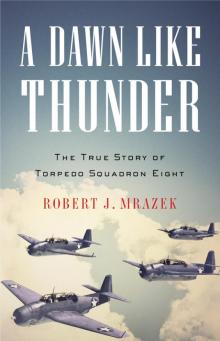 A Dawn Like Thunder
A Dawn Like Thunder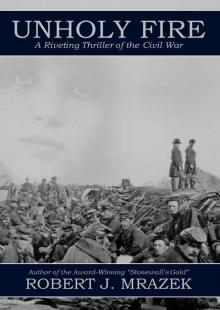 Unholy Fire
Unholy Fire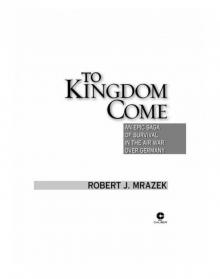 To Kingdom Come
To Kingdom Come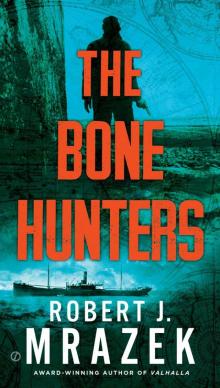 The Bone Hunters
The Bone Hunters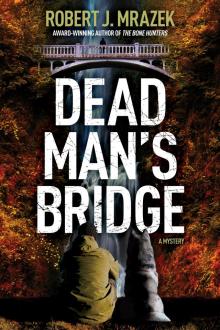 Dead Man's Bridge
Dead Man's Bridge